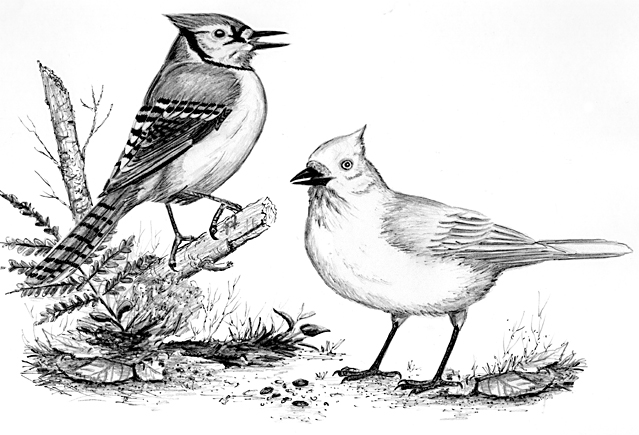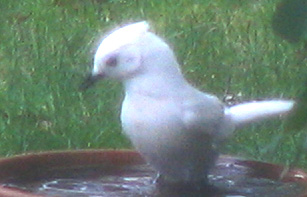
Dear Bird Folks,
I hope you can help us with this one. I photographed this bird today in our yard. (see attached). It appears to be all white! It seems to have a little bit of a Blue Jay shape. Is there such a thing as an albino bird? Any ideas?
Thanks. – Vince and Julie, Harwich, MA
Yup, Vince and Julie,
That sure is one crazy-looking white bird you took a picture of. It’s too bad everyone else out there in newspaper land can’t see your photo, too. It’s really freaky. It looks like a flying ghost. Wait! All ghosts can fly, can’t they? Has that ever been established or is it only cartoon ghosts that fly? Sometimes I get reality and cartoons mixed up.

Even though white birds are rare, they aren’t unheard of. The same day you sent your photo I received a note from a guy who saw a white junco on his recent trip to Yellowstone. Each year we get a handful of calls about some bird that has either a white head or white tail, but this is the first totally white one we’ve had. I’m glad you were able to get a picture of it because these birds don’t usually last very long. Birds like this are often abused and discriminated against, even by their own kind, just because they are white. Isn’t that an odd switch?
When I say “white birds” I’m not talking about birds that are normally white, like gulls, tern and egrets. I’m referring to creatures that stand out because their white coloring isn’t normal, like your white Blue Jay, or that white junco, or Michael Jackson.
Are all of these odd white birds albinos? Probably not. True albinism is pretty rare in nature. An albino bird would not only have all-white feathers, but the beak, feet and eyes would be pink. Why pink? Without coloring, the blood shows through. You can actually see the blood behind the iris, thus giving the bird that sci-fi pink eye look. I’m sure we’ve all woken up with eyes like that on occasion, but with these birds it’s permanent. I couldn’t tell if the Blue Jay in your photo had pink eyes, but the beak and feet are clearly black, the normal Blue Jay color. Your bird is more likely a partial, or incomplete albino.
Partial albinos are sometimes referred to as “leucistic.” There are actually scientific differences between albino and leucistic birds, but scientists can’t seem to agree on what those differences are. It has something to do with the lack of melanin and carotene, but I won’t go into that now. It is kind of boring, plus I don’t really understand it myself.
There are several causes of these random white birds. Often it is genetic, probably caused by some sort of mutation or too much partying by the parents. Exposure to pollutants or pesticides could also affect a bird’s plumage. Sometimes birds will grow a few white feathers after some significant trauma or injury. Improper diet my also cause some of these oddly plumaged birds. Birds that eat that cheap birdseed from discount stores, rather than the good stuff from birding specialty shops, probably suffer the most. I’m just saying.
If you were to do a quick search on the Web you would find all sorts of crazy-looking white, or partly white birds. One guy posted pictures of a bright white hummingbird coming to his feeder. There was another one of a totally white crow and a white robin. But the one that freaked me out the most was a two-toned, cardinal. If you looked at the bird head-on, the right side had the normal male cardinal colors, while the left side of the bird, though not white, was totally washed out. The result was a cardinal that looked like a male on one side and a female on the other; thus, allowing this bird to stroll into any locker room in the country without raising an eyebrow. Talk about a teenage boy’s dream.
Not every bird that has a pigment mutation becomes white, or washed out. Some birds have the opposite problem. They turn darker than normal, looking like they’ve had a little too much basting. There’s yet another way that birds become oddly colored, and it has nothing to do with genetics, or trauma, or basting. Sometimes their feathers become stained by the environment around them. This is particularly common during the nesting season when birds squeeze into tight nests.
Last spring a guy called me about a yellow-orange-ish woodpecker that was coming to his yard. I explained to him that the bird’s feathers were just stained from being inside the cavity of a tree. “No way,” he replied. He was certain that he was seeing an unusual bird, so he went over my head. That’s right. He called the Audubon Society. Dun, dun, dunnn! Well, the Audubon society said the same thing that I said, which totally surprised the guy…and me, too.
I’m glad you were able to take a picture of that weird white Blue Jay, Vince and Julie. Unfortunately, it probably won’t be around very long. It seems kind of cruel that nature gives these birds such odd looks, but things could be worse for them. They could look like Michael Jackson.